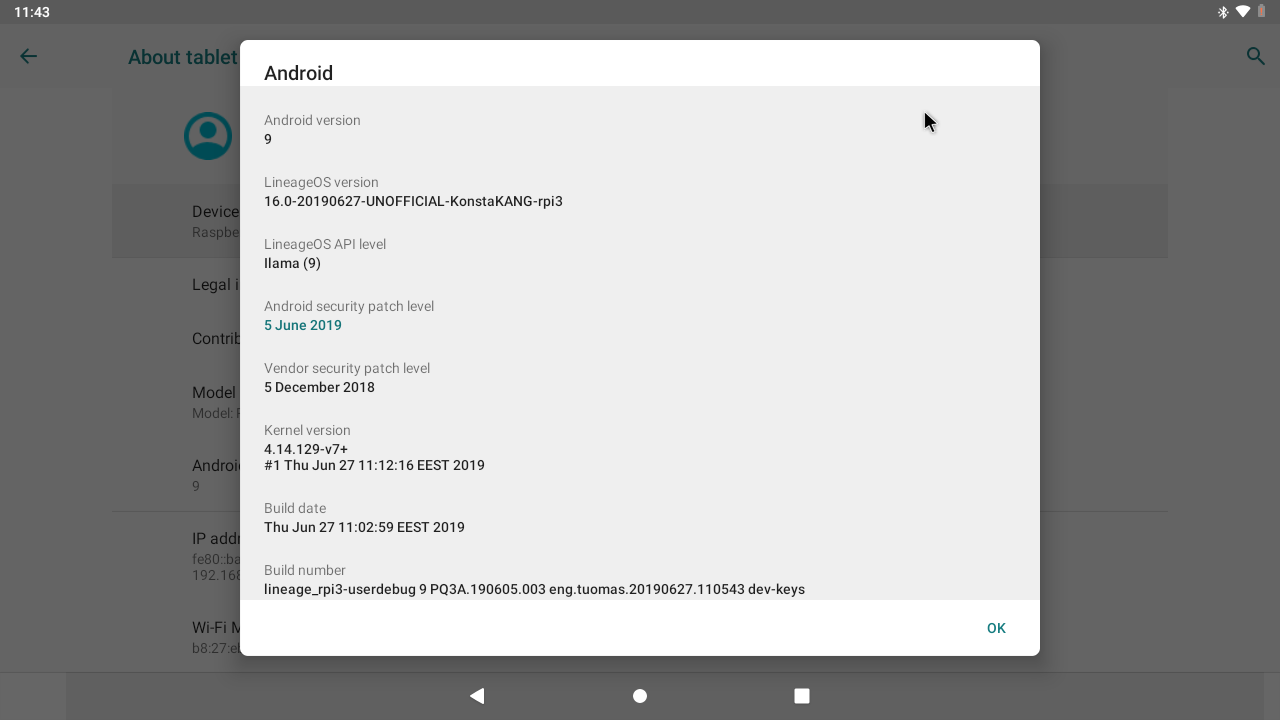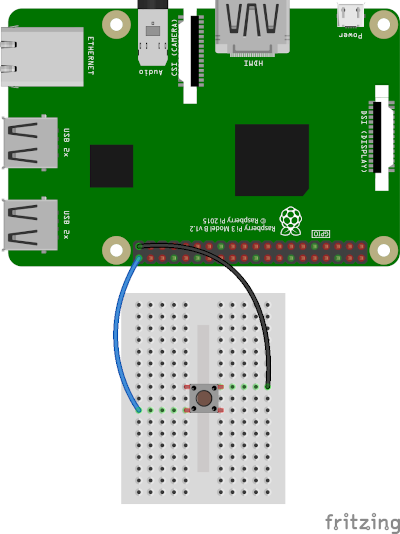Here’s my build of LineageOS 16.0 for Raspberry Pi 3 Model B and Model B+. It is unofficial and unsupported by the LineageOS team. It’s for advanced users only.
Important! This image includes parts that are licensed under non-commercial license (Creative Commons Attribution-NonCommercial-ShareAlike 4.0 International). You may use this build freely in personal/educational/etc use. Commercial use is not allowed with this build!

Do not mirror my builds! Please post a link to this page instead.
lineage-16.0-20200713-UNOFFICIAL-KonstaKANG-rpi3.zip
https://www.androidfilehost.com/?fid=8889791610682891697
md5:3689e767c41858bb53db20190b6542a5
Working:
- Audio (HDMI, 3.5mm jack, USB microphones, bluetooth speakers/headsets, etc)
- Audio DAC (using PCM512x DACs e.g. Hifiberry DAC+)
- Bluetooth
- Camera (using official Pi camera modules & UVC USB webcams)
- GPIO
- GPS (using external USB modules e.g. U-Blox 7)
- Ethernet
- Hardware accelerated graphics (VC4)
- HDMI display
- I2C
- IR remotes (using external GPIO IR modules e.g. TSOP4838)
- RTC (using external GPIO I2C modules e.g. DS3231)
- Serial console (using external GPIO serial console adapters e.g. PL2303)
- SPI
- Touchscreen/multi-touch (using official 7” display with SwiftShader software renderer)
- USB (mouse, keyboard, storage, etc)
- Wifi
- Wifi tethering
Not working:
- Hardware video decoding & encoding
Issues:
- SELinux is in permissive mode
- and more…
Sources:
Thanks:
- peyo-hd and everyone who has contributed to android-rpi
- brobwind for graphics and bluetooth fixes
- Eric Anholt for VC4 graphics driver
- Google for Android Things platform
- Android-x86 project
- LineageOS team & everyone who has contributed to LineageOS 16.0
How to install:
- Follow the official Raspberry Pi instructions for writing the image to the SD card.
FAQ:
Q: I can’t find developer options, why?
A: Settings -> About tablet -> Click ‘Build number’ several times
Q: I have no root, why? What is that hashtag on my status bar?
A: You need enable root access under Settings -> System -> Developer options -> Root access. Root management is now integrated as part of LineageOS’ Privacy Guard and you can manage per app permissions under Settings -> System -> Developer options -> Manage root access. You’ll have a persistent notification in the status bar when you’re running an app that uses root permissions.
Q: Settings -> Storage shows total system size of 4 GB. There’s unallocated space on my sdcard. What should I do?
A: This is a 4 GB image, remaining space on your sdcard will remain unallocated. Easiest way to extend /data partition is to simply flash my resize zip in TWRP.
Alternative option is to use e.g. GParted and extend /data partition (/dev/block/mmcblk0p4) to cover the unallocated space. Resizing the partition manually will break support for encrypting /data. Format /data in TWRP recovery (Wipe -> Format data) after resizing to leave required space for crypto footer.
Q: My display is not working. I can only see the rainbow screen but no Android boot animation. What should I do?
A: This build only supports HDMI displays that report supported resolutions using EDID. 1280x720 resolution is used by default with this build. You can change value in /boot/resolution.txt to use a different resolution that your display supports.
Q: I have official 7” LCD display and touchscreen. What should I do?
A: Official 7” touchscreen is only supported using SwiftShader software renderer. See below how to switch between different graphics drivers. You will also need to change display size under Settings -> Display -> Display size (or change ro.sf.lcd_density to 120 in /system/build.prop) to adapt to the smaller resolution.
Q: I need to use SwiftShader software renderer to use the official 7” display or I want to boot without any display connected. What should I do?
A: Warning, SwiftShader is a software renderer and using it affects graphics performance. You can switch between MESA and SwiftShader graphics drivers by executing following commands in ‘adb shell’/serial console/terminal (you can enable built-in terminal app from Settings -> System -> Developer options -> Local terminal):
su
rpi3-graphics.sh swiftshader
su
rpi3-graphics.sh mesa
Q: Raspberry Pi doesn’t have power button, how do I power off/reboot my device?
A: Following keyboard keys work as Android buttons: F1 = Home, F2 = Back, F3 = Multi-tasking, F4 = Menu, F5 = Power, F11 = Volume down, and F12 = Volume up. You can also use one of many third party reboot applications.
Q: How to create a DIY hardware power button?
A: You can send power button events by connecting GPIO21 to ground.

Execute following commands in ‘adb shell’/serial console/terminal (you can enable built-in terminal app from Settings -> System -> Developer options -> Local terminal) to enable the feature and reboot your device:
su
rpi3-powerbutton.sh
You can also use the DIY power button to boot the device to TWRP recovery. Press and hold the button while powering on the device until you see the TWRP screen. If you use this method to boot to recovery, you can ignore what is said about booting into/out of TWRP later in the FAQ.
Q: How to enable audio through 3.5mm jack?
A: Execute following commands in ‘adb shell’/serial console/terminal (you can enable built-in terminal app from Settings -> System -> Developer options -> Local terminal) to enable the feature and reboot your device:
su
rpi3-audio-jack.sh
Q: How to boot from USB device?
A: Warning, this is an experimental feature and there’s still some issues with it. Android shows USB storage notification for each partition and you should ignore these. TWRP shows errors in few places but everything seems to be working regardless of this.
- Follow the official instructions on how to enable USB boot on Pi 3 B (this step is not needed on Pi 3 B+)
- Write image to your USB device as above
- Mount the USB device on your computer and rename following files on the boot partition:
mv ramdisk.img ramdisk-sdcard.img mv ramdisk-usb.img ramdisk.img mv ramdisk-recovery.img ramdisk-recovery-sdcard.img mv ramdisk-recovery-usb.img ramdisk-recovery.img - Plug in the USB device to your Raspberry Pi, remove any sdcard, and boot
Q: How to boot to TWRP recovery?
A: There’s currently no proper way to boot between Android and TWRP, but this can achieved by renaming the ramdisk you want to boot. Execute following commands in ‘adb shell’/serial console/terminal (you can enable built-in terminal app from Settings -> System -> Developer options -> Local terminal) and reboot your device:
su
rpi3-recovery.sh
If mouse cursor doesn’t appear, try replugging your mouse.
Q: How to boot out of TWRP recovery?
A: You can execute the same script in TWRP terminal (Advanced -> Terminal) if you have boot and system partitions mounted (Mount -> Boot & Mount -> System):
rpi3-recovery.sh boot
Or you can flash my recovery2boot zip in TWRP.
Q: My device keeps booting into TWRP recovery. What should I do?
A: If you have GPIO21 connected to ground (or if you have something drawing power from it) your device will always boot to TWRP recovery (see FAQ section about DIY power button). If you have a hardware failure on GPIO21 you can edit /boot/config.txt to remove the GPIO21 related logic (see ‘Ramdisk’ and ‘Graphics acceleration’ sections).
Q: How to update from previous LineageOS 16.0 build without losing data?
A:
- Boot to TWRP recovery with the build you want to keep the data (see FAQ)
- Plug in an external USB storage device and select ‘Backup’
- Use ‘Select Storage’ to choose the USB device and ‘Swipe to backup’ (it’s only necessary to backup the data partition so you can uncheck other partitions to speed up the process)
- Write new LineageOS 16.0 image to the sdcard following installation instructions
- Boot to TWRP recovery with the new build (see FAQ)
- Select ‘Restore’ and find the backup you created from the USB device (‘Select Storage’)
- Make sure you only have data selected as partitions to restore (uncheck other partitions if available) and select ‘Swipe to Restore’
- (Flash Google apps package/other add-ons you had previously installed)
- Boot out of recovery (see FAQ)
Q: How to install Google apps?
A: Warning, installing gapps slows things down especially on low-end devices with limited amount of RAM such as this one.
- Download open_gapps-arm-9.0-pico-xxxxxxxx.zip and save it to your device’s internal storage or use an external USB drive
- Boot to TWRP recovery (see FAQ)
- Install open_gapps-arm-9.0-pico-xxxxxxxx.zip from your selected storage
- Wipe -> Factory reset!
- Boot out of recovery (see FAQ)
Merged commits not mentioned in the changelog.
13.7. changelog:
- add ir-keytable tool to configure IR remotes
- enable USB gadget support & fix adb toggle in developer options
- add support for storage devices with exFAT filesystem
- hide su binary when root access is not enabled in developer options
- add support for PCM512x audio DACs (tested with Hifiberry DAC+)
- improve support for Waveshare HDMI touchscreens
- fix recording videos with camcorder
- add TWRP flashable zip to resize data partition (see FAQ)
- update TWRP to 3.3.1-1
- update to MESA 20.1.3 and latest upstream versions of minigbm gralloc, drm_hwcomposer, and libdrm
- update to Linux 4.19.132 kernel and patch known vulnerabilities (CVE-xxxx-xxxx, and more)
- Android security patch level: 5 July 2020 (merged)
7.2. 2020 changelog:
- add camera HAL to support Pi camera modules and USB webcams (thanks to Android-x86)
- update to MESA 19.3.3 and latest upstream versions of minigbm gralloc, drm_hwcomposer, and libdrm
- enable hardware overlays (improves graphics performance)
- add option to switch to SwiftShader software renderer e.g. to use official 7” touchscreen or to boot without any display connected (see FAQ)
- fix portrait apps on forced landscape orientation (thanks to Ladehunter)
- update GPS HAL
- option to use DIY hardware power button to boot to TWRP recovery (see FAQ)
- initial support for IR modules and remotes (tested with TSOP4838)
- update to Linux 4.19.102 kernel and patch known vulnerabilities (CVE-xxxx-xxxx, and more)
- Android security patch level: 5 January 2020 (merged)
22.12. changelog:
- update to MESA 19.3.1 and latest upstream versions of minigbm gralloc, drm_hwcomposer, and libdrm
- set default resolution using a configuration file (see FAQ)
- add vendor init library to set serial number, revision, and resolution properties
- add health HAL to fake battery/charging
- add script to enable audio through 3.5mm jack (see FAQ)
- add initial support for RTC hardware (tested with DS3231)
- update to Linux 4.14.160 kernel and patch known vulnerabilities (CVE-xxxx-xxxx, and more)
- Android security patch level: 5 December 2019 (merged)
27.6. changelog:
- initial LineageOS 16.0 build
- hardware accelerated graphics (thanks to brobwind for putting the final pieces together)
- VC4 using Mesa 19.1 with drm_hwcomposer & minigbm gralloc
- fix bluetooth on Pi 3 B+ (thanks to brobwind)
- add initial support for booting from USB devices (see FAQ)
- add support for DIY hardware power button (see FAQ)
- update TWRP to 3.3.1-0
- update to Linux 4.14.129 kernel and patch known vulnerabilities (CVE-xxxx-xxxx, and more)
- Android security patch level: 5 June 2019 (merged)
Previous builds: